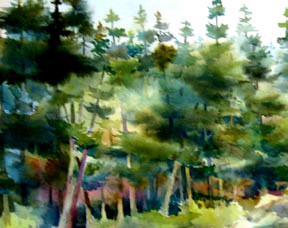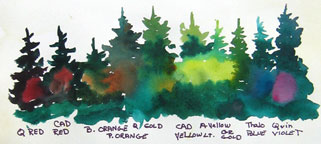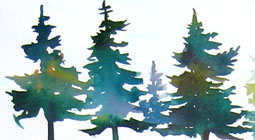 Summer is here and greens abound. As part of our long wet spring, grasses have never been thicker, trees and shrubs more luxuriant. Are you moaning about the green?
Summer is here and greens abound. As part of our long wet spring, grasses have never been thicker, trees and shrubs more luxuriant. Are you moaning about the green?
“I have so many problems with greens!”
“I can’t get the greens I see in nature….”
“Why do you have pthalo green? It is so STRONG!”
If this sounds like you, try some Green Exercises.
We will start with the last question. Why pthalo green — Winsor Green in the Winsor Newton colors — because it is strong and it is pure. It is what is called a prismatic color — think rainbow.True, we don’t see it in its pure state in the greens in the Northwest.
So we start with a pure, strong green –thalo or whatever is your strongest green.
 I put a puddle of mine in the middle of the page with all of my other pigments — green gold through all the yellows, reds, violets and blues around in a color wheel and mixed each with the thalo, getting a kind of a green. When you try it, be sure
I put a puddle of mine in the middle of the page with all of my other pigments — green gold through all the yellows, reds, violets and blues around in a color wheel and mixed each with the thalo, getting a kind of a green. When you try it, be sure  it is a kind of green… that the paint doesn’t become a red or a black.
it is a kind of green… that the paint doesn’t become a red or a black.
Here is another way — I show the pthalo green across the bottom, the hue I am adding in a pure swatch above and then use the two hues to make a fir tree.

Next are some trees where you just keep the green paint moving, letting a bit of orange show through  here, a bit of violet there. This is the way that greens occur in nature. And this is only with pthalo green! You could do the same with each of your greens. And! each of your blues.
here, a bit of violet there. This is the way that greens occur in nature. And this is only with pthalo green! You could do the same with each of your greens. And! each of your blues.
In the trees below, the third tree from the left is thalo blue. The small trees are the other pigment — oranges, reds, violets and greens. Note that even the reds and violets make hues which have a place scattered through the forest or garden.
The important thing is to keep the colors moving and changing, mixing on the paper instead of on your palette. Don’t forget to make some greens lighter and some darker, in all of the hue varieties, changing value as well as hue.

You may want to go to the Gallery section of the website and look at the different greens in various paintings. In addition to keeping the colors moving and mixing on the page, I frequently glaze, layering moving colors on top of others (more about that at a later date).
Your final assignment is to put the paints aside. Go outdoors and sit — in a forest, a meadow or a garden. Look at all of the variety of greens! Look for light greens and dark. Look for greens that are mainly yellow, for ones that register white as the sun bounces off the leaves. Look into the deep shadows. Do you see blue greens? Purple greens? Deep dark greens? And notice how there are little patches of pure orange, red and violet scattered through the greens. Notice how those hues wake up the greens.
Green is so much more than a tube of paint. Keep it on the move. And have fun!
© Caroline Buchanan, 2008
